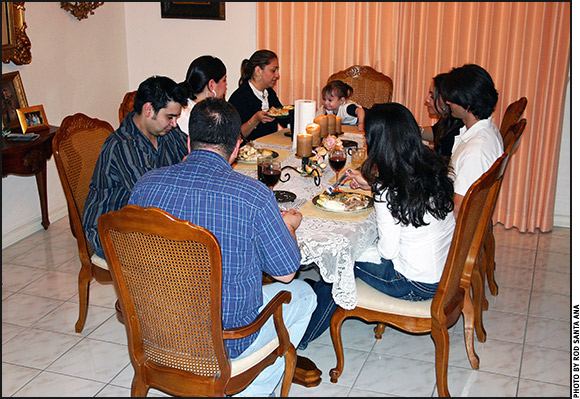
Substituting ingredients lower in calories and sugar can help make healthier holiday meals.
Recipe Alterations, Portion Control
Key to Healthful Holiday Eating
Tips to reduce calorie, sodium and fat intake in traditional holiday foods.
Overeating is as much a holiday tradition as watching football, so a Texas A&M AgriLife Extension Service expert has some tips on how to alter holiday recipes and make better food choices for healthier eating.
“Many times, the sugar, fat or sodium content of holiday recipes can be reduced without a noticeable difference in taste,” said Jenna Anding, AgriLife Extension associate department head, nutrition and food sciences, Texas A&M University, College Station. “In addition, there are several traditional holiday foods you can prepare in ways that don’t have a lot of extra fat or calories.”
If a recipe calls for a cup of sugar, try using two-thirds of a cup instead, she said.
“If reducing the fat content of a recipe is the goal, try using reduced-fat or nonfat cheese, milk, cream cheese, cottage cheese, yogurt or mayonnaise versus their higher-fat counterparts.”
She said another recipe alteration is to substitute evaporated milk for cream.
“For mashed potatoes, try using defatted broth instead of butter,” she said. “This can reduce both fat and calories. Just remember, though, low-fat doesn’t always mean fewer calories, so be aware of this when you’re making holiday food choices.”
Anding said modifying recipes may not always produce the desired texture or taste, so it’s a good idea to try the recipe in advance before serving it to others.
“Remember, processed foods typically have a higher sodium content, so people should be vigilant about checking food labels for sodium,” she said. “If there’s a choice between regular and reduced-sodium ingredients, choose the item with reduced sodium.”
Anding said many traditional holiday foods can be healthy and nutritious, so long as they are thoughtfully prepared and not embellished in ways that detract from their nutritional value.
“If you’re cooking a turkey, leave the skin on to contain the flavor, but then remove it afterward to reduce the fat content. Baste your turkey in its own juice or use a defatted broth, and when steaming or roasting, use just a small amount of oil or cooking spray for the healthiest way to cook your vegetables.”
She said adding herbs and spices to a recipe can add unique flavors without adding extra sodium, fat or calories.
“For example, sweet potatoes contain beneficial phytonutrients and antioxidant properties, as well as essential vitamins and minerals,” she said. “They’re a good source of fiber, are high in vitamins A and C and are a good source of manganese. They are also low in calories.”
Anding said a medium-size baked sweet potato only has about 100 calories, so a baked sweet potato with a little bit of brown sugar and cinnamon is a healthier option to one slathered in butter or cooked with a marshmallow topping.
“Cranberries are loaded with phytonutrients and are known for their anti-inflammatory properties,” she said, “Adding them to salads and baked items such as muffins, cookies and pies can be a way to sneak in some added nutrition and flavor.”
Even with healthier preparation, Anding said, portion control is still key when it comes to holiday eating.
“The holidays provide more opportunities to eat at family and social gatherings,” she said. “If you’re trying to avoid holiday weight gain, the key is to plan accordingly, so you can keep your calorie intake in check. And don’t forget to engage in a reasonable amount of physical activity to help burn off those extra calories and relieve the stress that often accompanies the holiday season.”
More food and nutrition information and resources from AgriLife Extension can be found at http://fcs.tamu.edu.

Editor’s Note: Paul Schattenberg is a media relations specialist and news writer for Texas AgriLife Communications.






